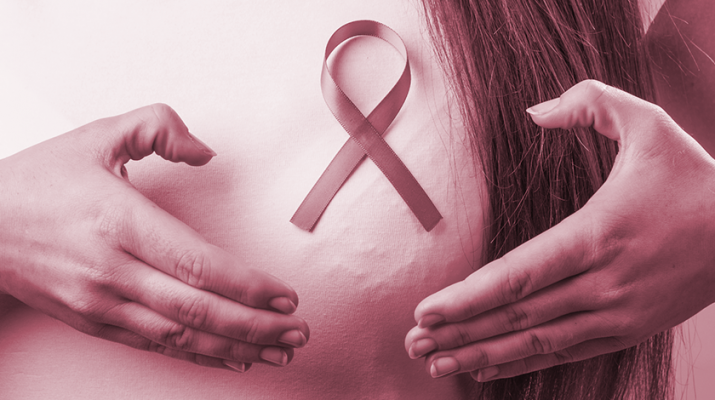October is Breast Cancer Awareness Month; learn preventive measures
By Rachel Evans
 Other than skin cancer, breast cancer is the most common cancer in women.
Other than skin cancer, breast cancer is the most common cancer in women.
Breast cancer is also the second-leading cause of cancer death in women, after lung cancer.
The chances are high that you know a woman who has been affected by breast cancer. Studies indicate that one out of eight women will be diagnosed with breast cancer in their lifetime.
October is Breast Cancer Awareness Month.
Early detection is important. If you have a family history of breast cancer, talk with your doctor about when you should get screened.
Chelsea Hammont, a physician assistant at Mohawk Valley Health System Breast Care Center, said there are potential signs and symptoms of breast cancer to be aware of, including:
— Lumps or hard areas in the breast
— Nipple inversion
— Bloody nipple discharge
— Skin rash or discoloration of the breast
— Skin dimpling or puckering
Mammograms can help to detect breast cancer even before you have a lump or growth.
Breast self exams are a good way to monitor what your breast looks and feels like, and can help you to be aware of any changes or irregularities when they do arise.
It is possible for men to get breast cancer, so both men and women should examine their own breasts monthly. For women, a good time to do this is three to five days after their period. If you notice any changes or anything you are worried about, make an appointment with your doctor to rule out any problems.
Here’s how to do a monthly self-breast exam:
— Using the pads of your fingers, move around your breast in a circular pattern moving from the outside to the center.
— Use your fingers on your right hand to exam your left breast and vice versa. Make sure to do this over the entire breast and near the armpit area as well.
— Pay special attention to any changes, lumps, or thickening.
— Make an appointment with your doctor if anything seems out of the ordinary.
In terms of screenings, the American Cancer Society’s current guidelines are as follows:
• Women aged 40-44 have the option to start screening by mammogram yearly.
• Women aged 45-54 should get mammograms yearly.
• Women aged 55 and older can switch to a mammogram every other year, or choose to continue to go yearly. Screening should continue as long as a woman is in good health and is expected to live at least 10 more years.
Genetic ties
According to Hammont, women with a family history of breast cancer affecting a first-degree relative (mother or sibling) should begin screening mammograms 10 years prior to the age at which their relative was diagnosed, but not before age 30.
Mammograms are not routinely recommended for women younger than 30 because the breast tissue tends to be quite dense and it is hard to visualize abnormalities.
Breast ultrasound is the preferred choice in patients younger than 30.
Hammont also suggests talking with your doctor if a first-degree relative was diagnosed prior to age 50, as there is genetic testing that can be done to see if you carry a mutation that increases the risk of developing breast cancer.
What should you expect during a screening?
— Mammogram is essentially an X-ray of the breast.
You may experience some discomfort during the test. If something is found during a mammogram, the doctor may issue follow-up testing. If a biopsy is needed, a doctor may use a thin needle to remove fluid or a small amount of tissue.
Mammograms are one of the best ways to detect cancer early. The earlier that cancer is detected, the better the treatment options and the more successful treatment will be.
For these reasons, screening for breast cancer is so important. Tomosynthesis or 3D mammograms are becoming more common. This provides 3D images to detect breast cancer.
— Breast magnetic resonance imaging may be used to screen women who are at high risk for getting breast cancer.
— Ultrasound may be done if a lump is felt but cannot be seen on an X-ray or if breast tissue is dense.
Aside from getting screened for breast cancer, Hammont said there are a variety of other ways to decrease the risks for developing breast cancer, including:
— Maintain a healthy body weight
“Being overweight, particularly after going through menopause, can pose a risk,” she said. “Fatty tissue stores estrogen and increased levels of estrogen in the body can contribute to the development of breast cancer.”
— Stay active
Hammont also underlines the importance of staying active.
“Aim for 150 minutes of moderate intensity activity each week, which is 30 minutes a day, five days a week,” she said.
— Minimize alcohol consumption and eat a wide variety of whole foods
This is beneficial to prevention as well.
Lastly, Hammont suggests minimizing exposure to exogenous hormones. “Hormone replacement therapy after menopause has been shown to increase the incidence of breast cancer,” she noted.
For more information, visit the American Cancer Society website at www.cancer.org.

